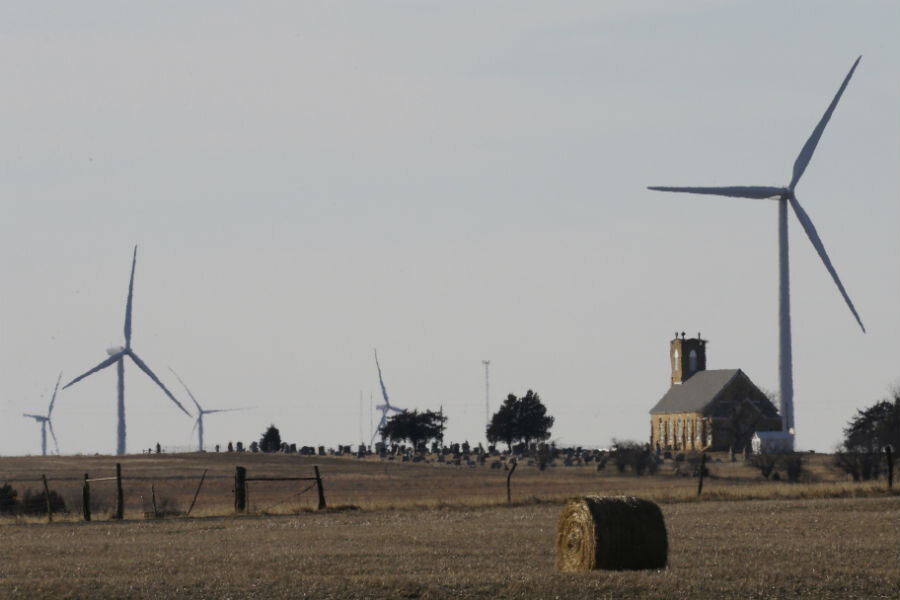Why do Americans want wind and solar power?
Loading...
On climate change, Americans are divided along rigid partisan lines, with few areas of overlap. There’s one exception: people across the political spectrum agree that the nation should grow its wind and solar resources.
The bipartisan popularity of wind and solar might provide a road map for clean-energy activists and civic leaders hoping to convince the public to back measures to boost the still-minuscule share of energy generated by those sources.
“The distinction here is that it shows broad-based support for expanding solar and wind and more mixed support for other forms of energy,” says lead author Cary Funk, in an interview with The Christian Science Monitor.
Eighty-nine percent of US adults say they favor more solar panel farms, and 83 percent favor more wind turbine farms, according to a survey released this week by the Pew Center. That support contrasts with public opinion on energy sources like coal, fracking, offshore drilling, and nuclear plants, where slim majorities in the fiftieth percentile oppose further development. Some 41 percent of Americans said they had thought seriously about installing solar panels at home, citing cost savings and environmental impact, with 4 percent actually having done it.
That's a sharp contrast to the ideological divides glimpsed in responses to other Pew Center questions on the topic. Less than a quarter of Republicans believe climate change stems from human activity, compared to almost 7 of 10 Democrats; Democrats are considerably more likely to trust that climate scientists will give full and accurate information on environmental changes, with only 15 percent of conservative Republicans believing that’s the case; and similar divisions play out on perceptions of the broad scientific consensus on the causes of global warming.
“What we can’t see here” in the latest survey, notes Ms. Funk, “is how people would prioritize investment in different areas.”
In a 2012 book “Navigating Environmental Attitudes,” University of Wisconsin sociologist Thomas Heberlein wrote that experts on environmental problems go wrong when they try to “educate the public” without taking into account prevailing attitudes. Technological fixes, he argued, “must be designed to be consistent with public attitudes.”
The Pew survey shows that at least over the short term, proponents of wind and solar technologies may find a way to “sell” communal solutions using the different ways they appeal to different crowds.
“People can easily project their values with wind and solar in ways that are difficult to do with other technologies,” says Alex Trembath, communications director at the Breakthrough Institute, an Oakland-based think tank on environmental issues. “A Democrat might really like solar because they care about climate change and clean air technology, and care about the evil fossil fuel industry. A Republican might care because it’s a decentralized technology ... you can put it on your rooftop, and not worry about a centralized authority.”
“You can imagine both on big scales or on very small scales. They come in all shapes and sizes,” he tells the Monitor. “It’s really a benefit to those technologies. If you’re a nuclear [power] advocate like I am, you wonder about how you can learn from it.
Low oil prices – and the fracking boom that has helped drive them down – have led at least some analysts to worry that renewable energy sources could begin to slip down the list of government priorities, as the Monitor noted in September. Americans remain divided over wether the boom in natural gas found in from shale formations, whose extraction has triggered earthquakes and contaminated water supplies, could serve as a bridge fuel to a low carbon future.
"You need subsidies for renewables because we are not there yet, by far,” former chief executive of the International Energy Agency Maria van der Hoeven told the Monitor in 2014. “You need subsidies not only for technologies that are economically more or less viable, but also for new technologies to come. Governments need to use their money to really push technology development and new types of renewable energy that are still in a lab stage or in a pilot phase.”
But with the price of wind and solar power falling fast, the International Energy Agency foresees a rosy future for these renewable energy sources – especially for solar, which the IEA thinks could go from less than 1 percent of the electricity market today to the world’s biggest source by 2050, reported Bloomberg last year.
Mr. Trembath says that the newness of wind and solar might also aid their popularity. “[T]he reasons to oppose it don’t jump to mind, and the association with any government policy isn’t the most immediate thing.”
[Editor's note: An earlier version misstated when the Monitor's interview with Ms. van der Hoeven took place.]
“It isn’t just marketing – wind and solar are legitimately clean ... but in abstract terms, Democrats, Republicans and everyone in the middle gets to project their values on the technology.”






